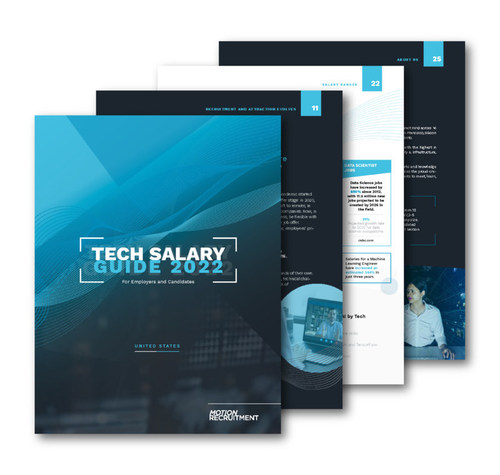Motion Recruitment, a leading North American provider of IT Staffing Solutions, just released the Motion Recruitment 2022 Tech Salary Guide, the annual report highlighting technology salary data, industry trends and market expert advice around hiring and job seeking. Following 2021’s rebound, this edition covers the insights and data needed to navigate this candidate-driven market, with key insights from Motion’s research shared below.
- Delayed demand has intensified the race for talent. Only 40% of companies hired IT workers they needed last year. With economic recovery, digital transformation and product innovation, the number of U.S. tech-sector jobs are at a record high of 4.76 million, and 68% of companies plan to hire up to 50 developers in the next year.
- Market-value compensation is rising. Salaries increased by 9.5% on average across major tech hubs for experienced hires, and with a 357% increase in remote IT jobs, companies basing salaries on location – not market value – may lose out on talent.
- Competition during hiring is high. Sign-on bonuses are offered nearly 5x more this year in an attempt to sway IT job seekers. Candidates for in-demand roles are seeing multiple, high offers; about half of tech workers say multiple rounds and scheduling errors are red flags. Hiring process and competitive first offers are more important than ever.
- Develop in-demand skillsets. With less than 2% tech unemployment as of August 2021, and 35% of developers with less than 5 years of experience, upskilling current and new employees will help close the 70% talent gap between supply and demand. 50% of organizations will hire a developer mismatched to their desired skillset, so invest in training opportunities to develop needed skills.
- Every tech employee could be a candidate weighing the options. 72% of tech professionals are considering leaving their job in the next year; 61% of HR professionals are already concerned about finding qualified developers. Prioritizing flexibility for tech workers applies to current, not just new employees, whether it pertains to work location, salary requirements or benefits.
“This is a challenging market to hire in,” said Matt Milano, President of Motion Recruitment. “Employers and tech professionals alike should consider revisiting pay ranges or desired salaries according to market value. It’s exciting to see all the opportunity for career growth in the industry, and employers can make their workplaces greater for having those conversations with employees now.”
“It’s also about more than just salaries,” Milano added. “Technologists want the whole package. Alongside compensation, IT professionals list technical challenges and flexibility for hours or better work/life balance among what matters most in a job offer, as well as company culture and advancement opportunities.”
Motion’s Tech Salary Guide provides employers and tech professionals the latest data, reporting and insights to better understand the market value of IT positions across cities and technology stacks. The information is based off thousands of technologists and verified against other industry leaders’ reporting to provide salary data for mid to senior level technologists, whether hiring or for their career growth.
Image licensed by pixabay.com
Related News:


